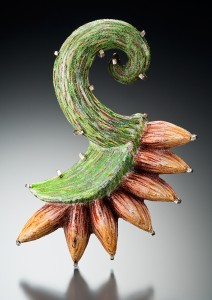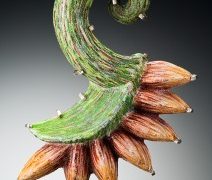Art and math are diametrically opposite, right? Wrong.

Blossom, layering of enamel over silver. Photo credit: Hap Sakwa.
Shana Kroiz is a Baltimore-based, acclaimed jewelry designer and artist, whose work has been shown in the some of the country’s most esteemed galleries and museums, including The Smithsonian and the Museum of Arts and Design in New York City. She’s kind of a big deal–and she does math!
When do you use basic math in your job?
Most days I contend with a variety of math problems, whether I’m measuring a piece or resizing a ring. I use wax to cast my designs, and so I have to convert the weight of wax into the the specific weight of the metal I am using. I also construct three-dimensional forms out of sheet metal, which requires some geometry. I have to know the sizes and weights of my pieces, so that they are not too heavy to be worn. When scoring and bending metal, I have to figure out the angle of my score lines in order to get the correct angle out of the sheet I am bending. Then there’s the business side of things: calculating the time it takes to make a piece with the cost of materials and the addition of any profit I need to make. Prices also have to be converted into a retail and wholesale values.
Do you use any tools to help with this math?
Yes, I use calculators, calipers, dividers, scales and, of course, computers. They all help with precision and time management.
How do you think math helps you do your job better?
Without math, it is almost impossible to do precision work. I work with a lot of potentially dangerous chemicals, and the math involved keeps me safe. Plus, if I mix the chemicals incorrectly, the result won’t be what I need. Being precise with my math means that I can avoid having to do things over again.
How comfortable with math do you feel?
I do most of the same sorts of problems over and over, so I feel comfortable in the studio, and can teach to my students. But there are times when I wish I had a deeper or broader understanding of how to use math. Sometimes I think I take too long to find the answers to calculations. If I understood how to use a different formula I might get to the answer faster.
Did you have to learn new skills in order to do this math?
Yes, but I had to work it out on my own. When I had a tangible need, I figure things out.
What kind of math did you take in high school?
I went through algebra and some geometry. And I didn’t feel like I was good at it at all! I could follow a problem if I had a model, but I did not have a good enough conceptual understanding of math to work out the formulas on my own. So I would say I was average at best, but I think if it had been taught in a way that I could understand I would have been much better. I do think if math was taught with more useful applications, students would have an easier time learning, understanding and being engaged in math as a useful tool for life.
Each Monday, I feature someone who uses everyday math in their jobs. If you would like to be featured (or if you know someone who you think should be featured), let me know at llaing-at-comcast-dot-net. You can also catch up on previous Math at Work Mondays.
